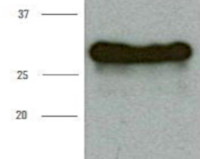1

Anti-BFP, GFP, YFP | Fluorescent Protein, clone 3A6
AS20 4485 | Clonality: Monoclonal | Host: Mouse | Reactivity: BFP, GFP, YFP
- Product Info
-
Sub class: IgG1 Immunogen: Recombinant EBFP (NCBI accession number AX_766758 REGION: 1-717, expression vector pGEX-1N), expressed in E.coli. Host: Mouse Clonality: Monoclonal Purity: Immunoglobulin Protein A purified in a 10 mM ammonium bicarbonate buffer, with 2 mg of BSA. Format: Lyophilized Quantity: 100 µg Reconstitution: Recommended antibody concentration: 0.5 mg/ml (when dissolved at 0.5 mg/ml, the BSA concentration will be 1%).
Recommended solvent; 100 mM PBS or Tris-HCl, pH 7.0 •
Additional sodium azide ( up to 0.05%) is recommended for long term storage. •
For a 0.5 mg/ml antibody concentration in 1% BSA, dissolve in 200 μl buffer.Storage: Store lyophilized/reconstituted at 2-8°C; once reconstituted make aliquots to avoid repeated freeze-thaw cycles. Please remember to spin the tubes briefly prior to opening them to avoid any losses that might occur from material adhering to the cap or sides of the tube. Tested applications: ELISA (ELISA), Western blot (WB) Recommended dilution: 1 : 150-1: 3000 (ELISA), 1 : 500-1 : 5000 (WB) - Reactivity
-
Confirmed reactivity: BFP, GFP, YFP - Application Examples
-

Specificity of Anti-Fluorescent Protein Immunoglobulin, clone 3A6, determined by ELISA. Antibody fraction (0.5 mg/ml) 1600X diluted in PBS containing 0,05% tween-20 and 5% non fat dry milk. Antibody was tested on various recombinant protein substrates i.e. BSA, 98% (Sigma), HIS6-hRrp4 (pET15b), GST-hRpp25 (pGEX-2T), GST-hRrp4 (pGEX-2T), HIS10-hRpp25 (pET16b), and a biotin containing peptide (22 mer).
1 µl of a total cell extract from E.coli, containing recombinant EGFP (predicted band size 27 kDa) was separated on SDS PAGE and blotted to nitrocellulose membrane. Primary antibody (0.5 mg/ml) was used at a dilution of 1: 1000 in PBS-T (0,05% tween-20) and 5% non fat dry milk. As secondary antibody anti-mouse IgG1 HRP conjugated was used and reaction was visualised with chemiluminescence, following manufacture's recommendations. - Background
-
Background: Fluorescent proteins, like EBFP, can be used as protein "tags" to study the subcellular localization of proteins and/or their translocation upon stimulation and/or as markers for transfections in transient and stable expression systems. - Protocols
- Antibody protocols
- Reviews:
-
This product doesn't have any reviews.


